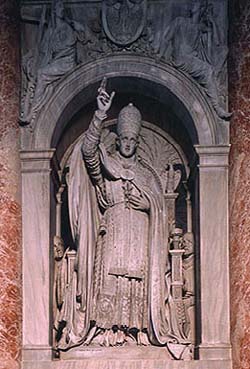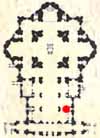 |
| Grottoes
Vatican City Colonnade Saints Floorplan #2 |
| Altars
Monuments The History |
|
Related Sites |

|
Made by Giuseppe de Fabris in 1835-36, this monument represents the pope standing and imparting his blessing Urbi et Orbi during the Jubilee of 1825. Barely seen behind the statue of the pope, are the heads of four of his cardinals. When Pope Leo XII was elected he tried to decline, citing his ill-health he told the cardinals, "You are electing a dead man". |
From: 'St. Peter's - Guide to the Basilica and Square'
Opposite is the Monument to Leo XII (1823-1829), who is shown in the act
of giving his blessing for the Jubilee of 1825. It was executed by G.
de Fabris (1790-1860). Above the statue, two reclining figures (Religion
and Justice) support the coat of arms. It should be noted that this is
not a real funeral monument because the Pontiff's body is buried in front
of the altar of St. Leo the Great.
Beneath this monument
is a door, usually closed, which leads into a small elliptical chapel.
This was at first called the Chapel of the Relics or of the Crucifix,
because it contains a wooden crucifix, attributed to Pietro Cavallini,
a 13th-century Roman artist. It then became known as St. Nicholas' Chapel
because although one of its two altars is dedicated to St. Joseph, the
other, with a mosaic of the saint make in 1711, is dedicated to St. Nicholas
of Bari
From:
'St. Peter's Basilica - A Virtual Tour' by Our
Sunday Visitor
Continuing along the aisle, on the right is the small Chapel of the Relics,
normally closed, in which an ancient ligneous cross, erroneously attributed
to Cavallini, is venerated and the heads of St. Petronilla, St. Damasus
Pope and of the Egyptian martyr St. Mena are preserved.
On the door of the
Chapel is the funeral monument to Leo XII, commissioned from G. Fabris
in 1836 by Gregory XVI. It shows a front view of the Pope standing while
giving his blessing, in a declamatory pose. In the background the heads
of his cardinals: Pacca, Odescalchi, Zurla and Cappellari, who was to
be Gregory XVI, can be seen.
Giuseppe De Fabris is the author of this sepulchral monument. The architectural
limitations, the empty expressive rhetoricism, and the inappropriate blending
of the figure of the main personage and the minor elements detract from
the monument dedicated to Pope Leo XII. However, it is the only sculpture
that presents the ceremony of the blessing "Urbi et Orbi," which we find
instead immortalized in various paintings of the 19th century, exalting
the magnificence of the pomp reserved for this event, which at the time
of Pope Paul VI will be definitively stripped of its magnificent ceremony
(the Pope continues on foot and no longer on the gestatorial chair, with
surrounding flabella, laic court, and noble guards).

